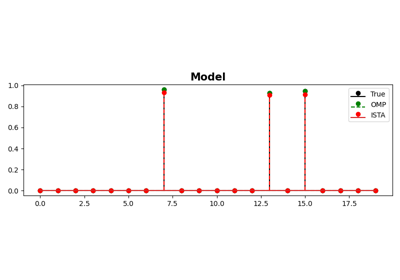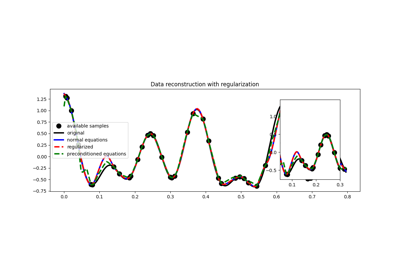pylops.optimization.sparsity.ISTA¶
-
pylops.optimization.sparsity.ISTA(Op, data, niter, eps=0.1, alpha=None, eigsiter=None, eigstol=0, tol=1e-10, monitorres=False, returninfo=False, show=False, threshkind='soft', perc=None, callback=None)[source]¶ Iterative Shrinkage-Thresholding Algorithm (ISTA).
Solve an optimization problem with \(Lp, \quad p=0, 1/2, 1\) regularization, given the operator
Opand datay. The operator can be real or complex, and should ideally be either square \(N=M\) or underdetermined \(N<M\).Parameters: - Op :
pylops.LinearOperator Operator to invert
- data :
numpy.ndarray Data
- niter :
int Number of iterations
- eps :
float, optional Sparsity damping
- alpha :
float, optional Step size (\(\alpha \le 1/\lambda_{max}(\mathbf{Op}^H\mathbf{Op})\) guarantees convergence. If
None, the maximum eigenvalue is estimated and the optimal step size is chosen. If provided, the condition will not be checked internally).- eigsiter :
float, optional Number of iterations for eigenvalue estimation if
alpha=None- eigstol :
float, optional Tolerance for eigenvalue estimation if
alpha=None- tol :
float, optional Tolerance. Stop iterations if difference between inverted model at subsequent iterations is smaller than
tol- monitorres :
bool, optional Monitor that residual is decreasing
- returninfo :
bool, optional Return info of CG solver
- show :
bool, optional Display iterations log
- threshkind :
str, optional Kind of thresholding (‘hard’, ‘soft’, ‘half’, ‘hard-percentile’, ‘soft-percentile’, or ‘half-percentile’ - ‘soft’ used as default)
- perc :
float, optional Percentile, as percentage of values to be kept by thresholding (to be provided when thresholding is soft-percentile or half-percentile)
- callback :
callable, optional Function with signature (
callback(x)) to call after each iteration wherexis the current model vector
Returns: - xinv :
numpy.ndarray Inverted model
- niter :
int Number of effective iterations
- cost :
numpy.ndarray, optional History of cost function
Raises: - NotImplementedError
If
threshkindis different from hard, soft, half, soft-percentile, or half-percentile- ValueError
If
perc=Nonewhenthreshkindis soft-percentile or half-percentile- ValueError
If
monitorres=Trueand residual increases
See also
OMP- Orthogonal Matching Pursuit (OMP).
FISTA- Fast Iterative Shrinkage-Thresholding Algorithm (FISTA).
SPGL1- Spectral Projected-Gradient for L1 norm (SPGL1).
SplitBregman- Split Bregman for mixed L2-L1 norms.
Notes
Solves the following optimization problem for the operator \(\mathbf{Op}\) and the data \(\mathbf{d}\):
\[J = ||\mathbf{d} - \mathbf{Op} \mathbf{x}||_2^2 + \epsilon ||\mathbf{x}||_p\]using the Iterative Shrinkage-Thresholding Algorithms (ISTA) [1], where \(p=0, 1, 1/2\). This is a very simple iterative algorithm which applies the following step:
\[\mathbf{x}^{(i+1)} = T_{(\epsilon \alpha /2, p)} (\mathbf{x}^{(i)} + \alpha \mathbf{Op}^H (\mathbf{d} - \mathbf{Op} \mathbf{x}^{(i)}))\]where \(\epsilon \alpha /2\) is the threshold and \(T_{(\tau, p)}\) is the thresholding rule. The most common variant of ISTA uses the so-called soft-thresholding rule \(T(\tau, p=1)\). Alternatively an hard-thresholding rule is used in the case of p=0 or a half-thresholding rule is used in the case of p=1/2. Finally, percentile bases thresholds are also implemented: the damping factor is not used anymore an the threshold changes at every iteration based on the computed percentile.
[1] Daubechies, I., Defrise, M., and De Mol, C., “An iterative thresholding algorithm for linear inverse problems with a sparsity constraint”, Communications on pure and applied mathematics, vol. 57, pp. 1413-1457. 2004. - Op :

